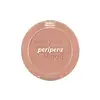What's inside
What's inside
 Key Ingredients
Key Ingredients

 Benefits
Benefits

 Concerns
Concerns

 Ingredients Side-by-side
Ingredients Side-by-side

Talc
AbrasiveMica
Cosmetic ColorantMethyl Methacrylate Crosspolymer
Diisostearyl Malate
EmollientOctyldodecyl Stearoyl Stearate
EmollientVegetable Oil
Skin ConditioningDimethicone
EmollientMagnesium Myristate
Isocetyl Myristate
EmollientHydrogenated Lecithin
EmulsifyingAluminum Hydroxide
EmollientTitanium Dioxide
Cosmetic Colorant1,2-Hexanediol
Skin ConditioningGlyceryl Caprylate
EmollientMethicone
EmollientHelichrysum Italicum Flower Water
Skin ConditioningCI 19140
Cosmetic ColorantCI 77742
Cosmetic ColorantCI 73360
Cosmetic ColorantCI 77499
Cosmetic ColorantCI 77007
Cosmetic ColorantTalc, Mica, Methyl Methacrylate Crosspolymer, Diisostearyl Malate, Octyldodecyl Stearoyl Stearate, Vegetable Oil, Dimethicone, Magnesium Myristate, Isocetyl Myristate, Hydrogenated Lecithin, Aluminum Hydroxide, Titanium Dioxide, 1,2-Hexanediol, Glyceryl Caprylate, Methicone, Helichrysum Italicum Flower Water, CI 19140, CI 77742, CI 73360, CI 77499, CI 77007
Isotridecyl Isononanoate
EmollientSqualane
EmollientDimethicone
EmollientDextrin Palmitate
EmulsifyingMethicone Crosspolymer
Polyglyceryl-2 Triisostearate
EmulsifyingVinyl Dimethicone/Methicone Silsesquioxane Crosspolymer
Sorbitan Sesquiisostearate
EmulsifyingPCA Dimethicone/Bis-Vinyldimethicone Crosspolymer
Skin ProtectingSilica Dimethyl Silylate
EmollientTocopherol
AntioxidantPhytosteryl/Octyldodecyl Lauroyl Glutamate
Skin ConditioningHydrogen Dimethicone
Dimethiconyl Silicate
CI 15985
Cosmetic ColorantTitanium Dioxide
Cosmetic ColorantMica
Cosmetic ColorantSilica
AbrasiveCI 45380
Cosmetic ColorantCI 77492
Cosmetic ColorantBarium Sulfate
Cosmetic ColorantPotassium Hydroxide
BufferingIsotridecyl Isononanoate, Squalane, Dimethicone, Dextrin Palmitate, Methicone Crosspolymer, Polyglyceryl-2 Triisostearate, Vinyl Dimethicone/Methicone Silsesquioxane Crosspolymer, Sorbitan Sesquiisostearate, PCA Dimethicone/Bis-Vinyldimethicone Crosspolymer, Silica Dimethyl Silylate, Tocopherol, Phytosteryl/Octyldodecyl Lauroyl Glutamate, Hydrogen Dimethicone, Dimethiconyl Silicate, CI 15985, Titanium Dioxide, Mica, Silica, CI 45380, CI 77492, Barium Sulfate, Potassium Hydroxide
 Reviews
Reviews

Ingredients Explained
These ingredients are found in both products.
Ingredients higher up in an ingredient list are typically present in a larger amount.
Dimethicone is a type of synthetic silicone created from natural materials such as quartz.
What it does:
Dimethicone comes in different viscosities:
Depending on the viscosity, dimethicone has different properties.
Ingredients lists don't always show which type is used, so we recommend reaching out to the brand if you have questions about the viscosity.
This ingredient is unlikely to cause irritation because it does not get absorbed into skin. However, people with silicone allergies should be careful about using this ingredient.
Note: Dimethicone may contribute to pilling. This is because it is not oil or water soluble, so pilling may occur when layered with products. When mixed with heavy oils in a formula, the outcome is also quite greasy.
Learn more about DimethiconeMica is a naturally occurring mineral used to add shimmer and color in cosmetics. It can also help improve the texture of a product or give it an opaque, white/silver color.
Serecite is the name for very fine but ragged grains of mica.
This ingredient is often coated with metal oxides like titanium dioxide. Trace amounts of heavy metals may be found in mica, but these metals are not harmful in our personal products.
Mica has been used since prehistoric times throughout the world. Ancient Egyptian, Indian, Greek, Roman, Aztec, and Chinese civilizations have used mica.
Learn more about MicaTitanium dioxide is a mineral UV filter widely used in sunscreens and cosmetics.
It is one of only two UV filters officially classified as “mineral” by regulatory agencies, the other being zinc oxide.
Titanium dioxide provides broad-spectrum protection mostly in the UVB and UVAII range, with some protection in the UVAI range.
While its UVA protection isn’t as strong as zinc oxide’s, the difference is minor.
A common myth is that mineral UV filters reflect UV light. However, modern research shows titanium dioxide absorbs UV radiation like chemical filters (~95% absorption & 5% reflection).
Thanks to its non-irritating nature, titanium dioxide is suitable for sensitive, acne-prone, or redness-prone skin. It is unlikely to cause "eye sting" like other sunscreen ingredients.
A major drawback of this ingredient is its white cast and thick texture. This is why mineral sunscreens often leave a white cast and are less cosmetically elegant than chemical/hybrid sunscreens.
To improve white cast and spreadability, micronized or nano-sized titanium dioxide is often used.
There are ongoing concerns surrounding nano-titanium oxide's impact on marine ecosystems.
There is no conclusive evidence that any form of titanium oxide (or any other sunscreen ingredients) will cause harm to marine ecosystems or coral reefs. The science is still developing but many consumers are keeping a close eye on this issue.
Please note, many destinations have reef-safety sunscreen rules. For instance, the U.S. Virgin Islands advises all visitors to use non-nano mineral sunscreens.
Nano mineral sunscreens once raised safety concerns about absorption into skin.
Extensive research has shown that they do not penetrate healthy or damaged skin; they remain safely on the surface and the top layer of dead skin (stratum corneum).
You'll likely find titanium dioxide bundled with alumina, silica, or dimethicone. These ingredients help make titanium dioxide highly photostable; this prevents it from interacting with other formula components under UV light.
Learn more about Titanium Dioxide